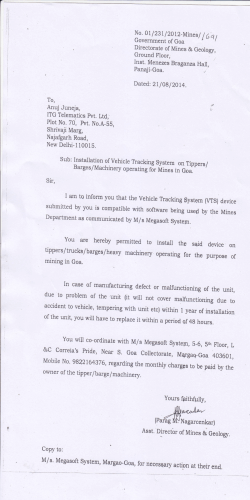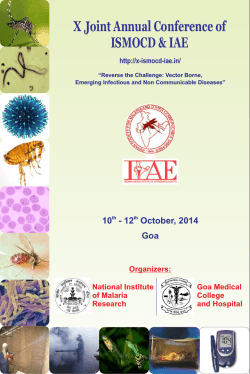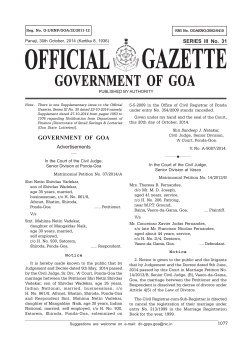
Document 390454
Paper No. A21A-0010 Stable Carbon and Nitrogen isotopic characterization of bulk atmospheric particles over Indian coastal site (Goa) during monsoon, postmonsoon and winter periods of 2011-2012 Kamana Yadav1*, Rajesh Agnihotri2, Vedula .V.S. Sarma3, Supriya G. Karapurkar1, Praveen Kumar Poosarla3, M. Dileep Kumar1 2012 AGU Fall Meeting 1.CSIR- Chemical Oceanography Division, National Institute of Oceanography, Goa, India. 2. CSIR-Radio & Atmospheric Science Division, National Physical Laboratory , New Delhi, India. 3. CSIR-Bio-Geochemistry Lab, National Institute of Oceanography, Visakhapatnam, India. *Corresponding author Email: [email protected] 3. Instruments- 2. Study Region- 1. Introduction and Objectives- Ambient bulk atmospheric aerosols (TSP) were collected using a high volume air sampler (APM 430 , Envirotech) with typical air flow rate ~1.2 m3 per minute. Mass concentrations of TC & TN and their isotopic composition were measured using Elemental Analyzer (EA) coupled with a Delta V plus stable isotope mass spectrometer (Thermo®) in a continuous flow mode. Atmospheric carbonaceous aerosols especially over coastal regions could influence regional biogeochemical cycles of biogenic elements e.g. carbon (C) and nitrogen (N), radiation budgets and hydro-chemistry of wet precipitation. They may have multiple primary sources of natural and anthropogenic origin and may undergo several complex secondary processes after formation before their eventual removal via dry/wet precipitation. Detailed chemical and stable isotopic characterization of such atmospheric particles can greatly help in identifying source and secondary atmospheric processes. Toward this we collected nearly 60 bulk aerosol samples from the roof of National Institute of Oceanography (NIO), Goa ((15.46N, 73.8E; at a height ~ 55.8 MASL) from mid 2011 to early 2012 and analyzed mass concentrations of total carbon (TC) and total nitrogen (TN) together with their isotopic values (d13C, d15N). Overall objectives of the present study are- 4. Methodology- • To determine chemical and isotopic parameters of ambient bulk aerosols present in lower atmosphere over Goa in different seasons e.g. monsoon, post-monsoon and winter periods. We have adapted a modified methodology as discussed in detail, in Agnihotri et al. (2011). In brief, aerosol samples were collected on pre-combusted and pre- desiccated Tissue quartz (Pall; size 8×10”) filters. Sub-aliquots of 1 cm diameter were cut from the collected filters. For measurements of TC, TN contents and their isotopic ratios (d13C and d15N) one or two aliquots were taken out and placed in pre-clean Tin cups and made round pellets which were then combusted in an Elemental Analyzer connected to a Delta V Stable isotope ratio mass-spectrometer (Thermo). 13C/12C and 15N/14N ratios of sample gases are then measured with respect to automated injections of standard (calibrated) CO2 and N2 gases. Final results are expressed as d13C and d15N relative to PDB and atmospheric N2 standards respectively, and defined as: d13C and d15N = [(Rsample/Rstandard)-1]×1000----------------------- (1) • To assess influence of local meteorological (MET) parameters on measured chemical and isotopic characteristics by analyzing contemporaneous MET data. R denotes 13C/12C and 15N/14N ratio in sample and standard. Schematics of isotopic analyses of aerosol samples are shown in Fig.2. Fig. 1: Sampling site at Goa (India) and the high volume air sampler (APM 430; Envirotech) used for bulk aerosol sampling in the study. 5. Results- 6. Conclusions- Rounded layered structure Crust particles Grape-like structure formed of Carbon monomers Flattened particle Triangular flake structure Glass like angular particles Fig 2: Average mass concentrations of TC, TN and TSP (as shown by circular, square and diamond symbols) along with associated ranges observed (as shown vertical uncertainty bars) in ambient aerosols over Goa during monsoon, post monsoon and winter period of 2011-2012. Angularbulk structure Fig 3: d15N and d13C variations in ambient aerosols over Goa Bent structure channels of ambient temperature, relative humidity and wind Fig. 4:with Covariance ( O, C, N and Si rich ) during monsoon, post monsoon and winter period of 2011-2012. speed with measured TSP concentrations over Goa during monsoon period of 2011-2012. Rounded particle (bio-aerosol) 6. Future work- The average mass concentrations of TC, TN and TSPM (Fig. 2) during monsoon were found to be 8.15±5, 1.34±0.8, 67.5±31 mg.m-3, respectively (n=7). In post monsoon period TC and TN mass concentrations show a substantial increase with 18.4±7.2, 3.16±2.3 mg.m-3, respectively (n=6), but TSP concentrations showed a marginal decrease with an average value of 57.7±35 mg.m-3. Aerosol samples during the winter of 2011-12 (a total of 30) show highest mass concentrations of TC, TN and TSPM with average values 29.1±9.5, 6.14±2.3, and 109.6±30 mg.m-3, respectively. A narrow range (average: 22.8±2.7‰) of δ13CTC was observed compared to a wider range of δ15N (average: 12.7±5.1‰) during entire sampling campaign. Significantly lower d15NTN values were found (average: 3.0±0.5‰) during monsoon period as compared to those for post monsoon (average: 12.3±3.8‰) and winter periods (average: 14.2±3.8‰). Lower d15N values are similar to those during pre-monsoon period (Agnihotri et al., 2011) and thereby attributable to incorporation of isotopically depleted nitrogenous compounds originating from adjacent Arabian Sea. TSP concentrations show covariance with local MET parameters during monsoon. The relationship appears to be weakening during post-monsoon. Winter TSP masses apear not to be influenced by local MET variables (Fig. 4), instead prevailing wind circulation pattern bringing carbonaceous material from north-northeastern parts of India, appears be dominating chemcial and isotopic characteristics of ambient bulk aerosols over Goa (Fig. 3). References- Inter-relationships among measured chemical and isotopic characteristics of atmospheric bulk aerosols along with local meteorological parameters are being further investigated. Agnihotri, R., Mandal, T. K., Karapurkar, S., Naja, M., Gadi, R., Ahammed, Y. N., Kumar, A., Saud, T., and Saxena, M. (2011) Stable carbon and nitrogen isotopic composition of bulk aerosols over India and Northern Indian Ocean, Atmos. Environ., 45, 2828–2835, 2011 Analyses of inorganic constituents of aerosols such NH4+, NO3- along with other major ions are also being carried out, that will help us to better understand seasonal changes in complex tropospheric chemistry in a typical tropical costal environment. . Narukawa, M., K. Kawamura, N. Takeuchi, and T. Nakajima (1999) Distributions of dicarboxylic acids and carbon isotopic compositions in aerosols from 1997 Indonesian forest fires, Geophys. Res. Lett., 26(20), 3101–3104, doi:10.1029/1999GL010810. AcknowledgementsThe authors are thankful to Director CSIR-NIO (Goa) for consistent support and facilities. Dr. P. Mehra (NIO) kindly provided contemporaneous meteorological data measured by automated weather station (AWS) installed at NIO-Goa.
© Copyright 2025


















